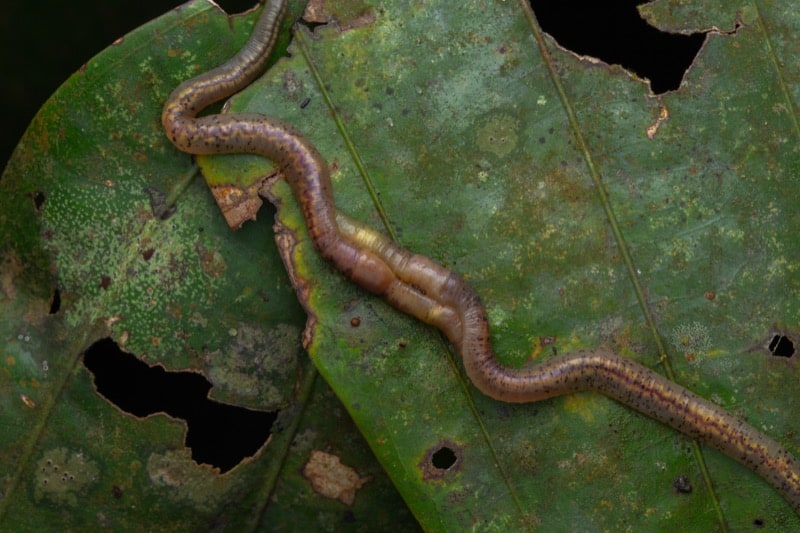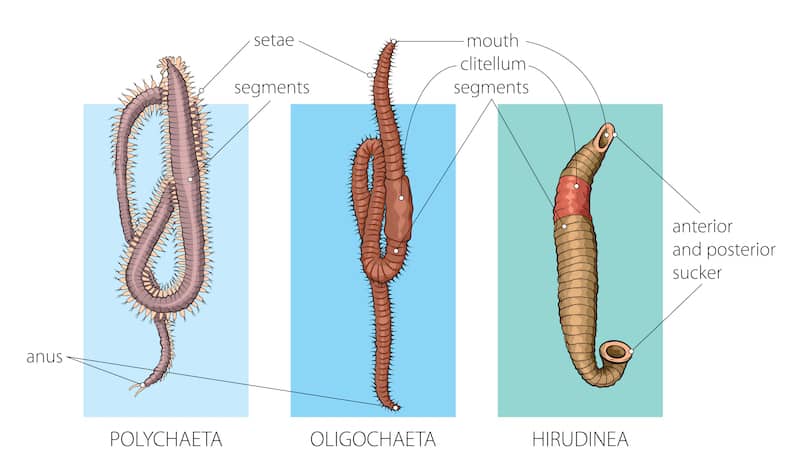So, what do we know about earthworms, our friends of the soil, and how they manage to increase their population?
Considering the physiology of a worm, it’s natural to wonder how they reproduce. Do worms lay eggs? Do they have babies? You may not believe it, but earthworms are hermaphrodites. They possess both male and female reproductive organs, meaning they are not characterized by a specific gender.
Although earthworms possess both male and female reproductive organs, however, they still require another worm’s participation to reproduce.
This article will look into how worms reproduce.
Do Worms Lay Eggs?
Yes, a worm will lay eggs, just not necessarily as we might imagine. They do not lay eggs like a bird in a nest. They actually lay cocoons that are the size of a grain of rice.
These cocoons are a luminescent white and inside is where the worm’s eggs are found. Each cocoon can produce anywhere from 2 to 20 baby worms. In the right environmental conditions, the worm babies will hatch out in 2 to 11 weeks.
How Do Worms Mate?
First, let’s consider the anatomy of a worm. We see a slithering tube-like creature that will vary in length. But each worm will possess a clitellum, where the reproduction organs are.
This clitellum is a glandular section positioned near the head of earthworms. It is a thick ring that is generally lighter in color. This gland secretes what is known as a viscid sac in which eggs are stored in order to create a cocoon.
The clitellum will form only when a worm is sexually mature at about six weeks of age. The male and female reproductive organs are found inside the clitellum.
To mate, two worms will join together by making contact at the clitellum but with the head of each worm pointing in the opposite direction. When they connect at the clitellum, they release a mucous membrane with both worms fully protected within the membrane for mating purposes.

The worms will then pass sperm to the other. The individual worms store the sperm in sacs that are seminal receptacles. Once this happens, mating is completed. At this point, the worms separate and go on about their business.
The formation of the cocoon begins immediately after the two adult worms separate from each other after they have mated.
How Do Worms Give Birth?
Worms do not actually give birth as baby worms hatch from eggs. They are not a part of a live birth process. The closest thing that might resemble giving birth, is when the cocoon filled with eggs is deposited.
Each worm now forms its own individual tube of mucous. This tube will move over the exact point where the worm is storing the eggs. The eggs latch onto this membrane and attach to the inside of this mucous membrane.
Once the mucous tube with the eggs reaches the seminal sac or receptacle, the sperm makes contact with the eggs.
A cocoon forms on the clitellum of each worm. As the worm moves backward away and out from the cocoon, both eggs and sperm are deposited inside the cocoon and the ends of this tube-shaped cocoon are sealed off.
The cocoon is deposited and the sperm inside proceeds to fertilize the eggs. On average, there will be as many as twenty potential worm embryos inside the cocoon.
Worm gestation can last anywhere from two to eleven weeks. During this time, the mucous membrane provides all the necessary nutrients for the developing embryos. Once gestation has been completed, newborn worms will emerge from the cocoon and burrow down into the soil bed to begin their new lives.
If soil conditions are not conducive to hatching, the cocoon will lie dormant until conditions improve sufficiently enough to permit hatching.
What Do Worm Eggs Look Like?
The appearance of the cocoon with the worm embryos will vary from worm species to species. Some may appear tiny, about the size of a rice grain or grape seed.
Most eggs will begin as whitish in color, but will deepen to golden as the gestation matures. Unfortunately, less than 50% of worm embryos will usually survive to hatch.
Regardless of individual size, worm eggs will harden as they mature and deepen in color until turning brown. They will then turn a very dark burgundy red when they are ready to hatch.
What Do Baby Worms Look Like?
Baby worms that have just emerged from their eggs will be translucent white in color. At birth or hatching, they measure between a half-inch and an inch in length. Baby worms are skinny and appear more like a piece of thread than like a worm, so they won’t really stand out when you are working or digging in your garden.
If you see what appears to be hairy growth in the garden soil, it may be a large group of hatchlings. Shortly after birth, within a few hours, baby worms develop hemoglobin and begin their transformation from white translucence to pink or red in color.
If you spot these, they will appear as a smaller version of an adult worm but will not feature the clitellum band on their bodies.
The absence of the clitellum indicates that a young worm is not fully mature sexually and cannot yet reproduce.
Do Worms Have Genders?
Earthworms are what are known as simultaneous hermaphrodite organisms. This means that each individual worm will have both the male and female sexual reproduction organs within their bodies.
Some earthworm species may even be capable of asexual reproduction. This process will see an individual earthworm produce baby worms from eggs that have not been fertilized. The process is called parthenogenesis.

Why is Worm Reproduction Good?
If you are a home gardener, then you can appreciate the importance of earthworms in the garden soil bed. For the common gardener, not a lot is known about these precious garden inhabitants because they spend most of their life underground, so you won’t be witnessing a lot of their activities.
Earthworm ecology, nonetheless, brings lots of benefits with it when it comes to the soil in our garden beds.
Earthworms improve soil drainage, soil aeration, and help increase the availability of important nutrients found in the soil, which in turn helps to better our garden’s productivity.
In fact, a study in Tasmania and New Zealand went so far as to demonstrate that when worms were introduced into worm-free pasture lands, the pasture growth increased from 70 to 80%.
Composting worms are also useful for breaking down organic waste in the compost pile. Vermicomposting produces worm casting (worm poop) that becomes black gold fertilizer for plants.
These small creatures do a lot of good and are fundamental for a garden’s ecosystem and its productivity.
Worm Reproduction Final Thoughts
Earthworms play a vital role in the health of our gardens and we should make sure to keep them around. They are essential to the soil and plant ecosystems and provide us with many benefits.
Worms do lay eggs, although as hermaphrodites, their reproduction process is quite unique.
They are also very interesting because they’re capable of regenerating segments of their bodies that were cut off or detached due to some misfortune. Although it is more common when the tail detaches, larger detachments and subsequent regrowth have been known to take place.
Some other articles on worms that you might be interested in:

